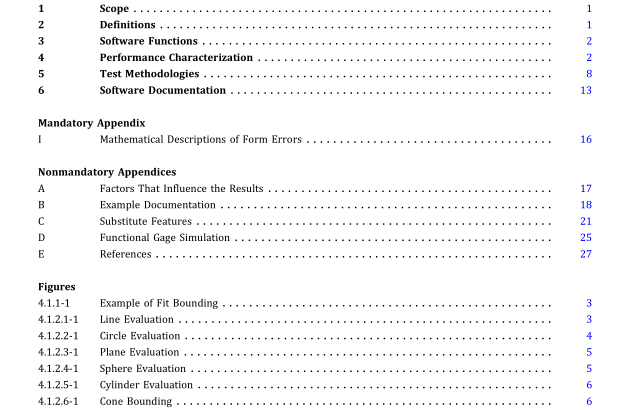ASME B89.4.10-2021 pdf free download.Methods for Performance Evaluation of Coordinate Measuring System Software
SOFTWARE FUNCTIONS In normal usage, CMS hardware is used to collectdata points (raw data) on the surfaces ofparts being inspected. CMS softwarecanprocess theserawdatato constructdatums, partcoordinate systems, and substitute features thatrepresent the surfaces being inspected. From these constructions, the CMS software can evaluate such characteristics as size, location, orientation, and form.
3.1 Input Data
Rawdata to be used to testand analyze CMS software maybe obtained byphysicallyinspectinga testworkpiece or by mathematicalcomputation. Theformerrepresents atestoftheentiremeasuringsystem,whilethelatterapproachavoids operator, workpiece, environment, and machine influences.
The latter approach also makes it possible to more closely control the raw data sets, including limits on their spatial distribution, as well as inclusion of artificially induced form errors. For software analysis, the latter approach is the most universally accepted and the most reliable. This is the approach addressed herein.
3.2 Data Analysis
The raw data points are processed by mathematical algorithms with the purpose to calculate perfect-form substitute features. First, substitute features are calculated to represent the original data. Then the substitute features are used to evaluate conformance to tolerances or to determine other geometric characteristics ofthe workpiece. An alternative to the use of substitute features is the use of Functional Gage Simulation, described in Nonmandatory Appendix D. Differentmethods canbeusedforobtainingsubstitutefeatures. Thesemethodsmayhavedifferentobjectivefunctions, i.e., different criteria for deciding that a particular substitute feature is better or worse than other possible substitute features. Different criteria can, in general, lead to different results. The proper selection of fitting criterion and data analysis method is outside the scope ofthis Standard. Fitcriteria are usuallybased on L P -norm estimation, or minimum- circumscribed, or maximum-inscribed methods. Refer to Nonmandatory Appendix C for explanations ofthese methods.
The objective ofthis Standard is notto decree thatanyone methodis betterthan anyother. Guidance is providedto the user for checking whether particular CMS software produces results that agree sufficiently closely with the reference results within the context of the design requirements.
4 PERFORMANCE CHARACTERIZATION
This sectionestablishes thecharacteristics bywhichCMS software performanceis evaluated. These characteristics are discussed in terms offourcategories: quality, robustness, reliability, and ease ofuse. Characteristics thatare notused for performance evaluation in this Standard are discussed at the end of this section.
4.1 Evaluation of Quality Inthis Standard, the qualityofthealgorithmis evaluatedonthebasis ofthegeometricdeviationofthetestfeaturefrom a reference feature.
4.1.1 EvaluationConcept.
Somefeatureshaveunboundedgeometry,e.g.,lineshaveinfinitelength.Forthepurposesof evaluation, unbounded features are bounded by their sample point sets. The resultant bounded test feature is then compared to the reference feature.
Evaluation parameters are defined for each type of feature (see Figure 4.1.1-1). 4.1.2 EvaluationParameters.Eachfeaturetypehasauniquesetofevaluationparameters.Testresultsarereportedas outlined below. The figures in this section have the following annotation conventions:
A = angle
a = cone half-angle
D = separation distance
R = reference fit parameter subscript
r = radius
t = test fit parameter subscript
4.1.2.1 ð21Þ Line. The test line is bounded by the perpendicular projection of the sample points onto the test line. The evaluation parameters are (see Figure 4.1.2.1-1)
(a) the largest separation distance between the bounded test and reference features
(b) the angle between the test and reference features
4.1.2.2 ð21Þ Circle.
(a) The test circle is a closed object and naturally bounded. The evaluation parameters are as follows (see Figure 4.1.2.2-1):
(1) the absolute value of the difference between the radii of the test and reference circles (|r R − r t |).
(2) the distance between the centers of the test and reference circles. This may be a three-dimensional distance.
(3) the angle between the planes of the test and reference circles, if applicable (see Table 4.1.2.2-1).
b) In the case ofleast-squares fittingofcircles (in three dimensions), the least-squares fitcan be defined in two ays.
(1) The first way is to
(-a) fit the points to a least-squares plane
(-b) project the points into that plane
(-c) fit a circle to the projected points, which is a two-dimensional fit
(2) Thesecondwayistodefinetheobjectivefunctionasthesum-of-squaresofthethree-dimensionaldistancesfrom the points to the circle in space; the fit circle is then the one that minimizes that objective function.ASME B89.4.10 pdf download.ASME B89.4.10-2021 pdf free download
